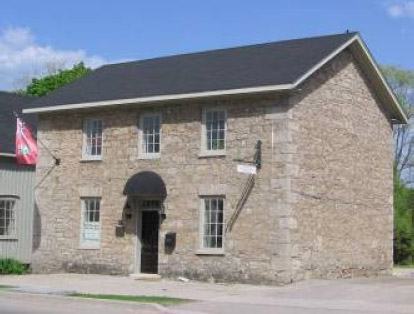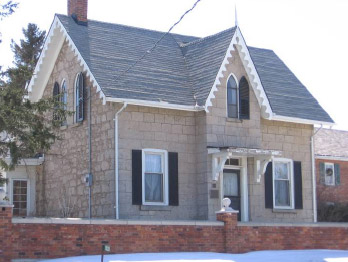Download PDF Copy of Architectural Styles of Stone Buildings of Ancaster
Text by Robert Williamson, Feb. 29, 2008
With photos by Gerard Middleton
Research by Jim Green
Ancaster Township has an abundance of stone buildings, bridges and walls that were
constructed between 1800 and 1900. Hence Ancaster has become a unique time capsule
of interesting stone buildings representing several periods of design and styles that are
seldom found collectively in other Ontario communities.
I. NEO-CLASSICAL COTTAGE, 1810 – 1850
This is the earliest style of stone architecture in Ancaster. It began with the end of the
War of 1812 when pattern books of classical detailing were available from England.
These buildings were constructed on the traditional or simple, Georgian one-storey box
plan. They have the following identifiable features.
- The front door is central with glass sidelights and a transom, usually fan shaped.
- The door may have optional pilasters to look like columns or a small portico with
or without real pillars.
- The two front windows are always 12 pane sash windows.
- There is a double chimney, one at each end of the house.
- The corners are usually finished in sandstone decorative quoins.
Examples:–
John & James Calder or Andrew Sloss House (built 1842 or ca 1855?), 372 Butter Road, Carluke

Figure 1. 372 Butter Rd
Peter Gordon & Paddy Green
cottages, (built ca.1850), have all the
neo-classical features but have been
altered in appearance with their
modern second story additions.

Figure 2. 104 Paddy Green Rd
Major McFarlane’s home, (built
ca.1820), at 688 Governors Road is
a typical neo-classical design
except for the addition of a modern
dormer and a modern portico.

Figure 3. 688 Governor's Rd
Mountain Park, also known as Oak
Knoll, the Robert Berry home, 271
Lime Kiln Road (built ca 1822).
Robert married Helen Eliza,
daughter of William Butler, or
Butler’s Rangers fame). It is a
beautiful example of a pillared
portico -- the dormer is a modern
addition. This house is unusual
because it is asymmetrical with
two windows on the right side.

Figure 4. 271 Lime Kiln Rd
The John Lampman home, (built 1854), 1021 Garner Rd E has all the neo-classical
features but the large portico is a modern addition and is unpleasantly disproportional.

Figure 5. 1021 Garner Rd East
II. NEO CLASSICAL TWO STOREY
This style has all the features of the classical cottage except that it has a second storey
with three windows across the front. The majority of the buildings were built after 1850
for a more affluent society.
Examples:–
Seymour Lodge, 419 Wilson E (built ca. 1820) originally looked like the white plaster
coated stone building beside it (“the 1812 barracks”). Both of these Neo Classical style
buildings are probably the oldest stone buildings remaining in Ancaster. The lodge was
extensively remodeled and the roofline changed in 1914.

Figure 6. Seymour Lodge, 419 Wilson St
The Phillipo house, 398 Wilson St E,
was built in the1840s by James
Phillipo, a stonemason who came
from England about that time. His
son John sold it soon after his
father’s death in 1850. Since this is a
stone mason’s home we can say that
it is the quintessential example of a
two-story neo-classical design except
that the chimneys are missing. Note
the portico feature has been retained
with the addition of a modern
portico.

Figure 7. The Phillipo House, 398 Wilsonv St
III. REGENCY VILLA STYLE 1820 –1860
This style was named for King George IV Regency. It was a style adopted by retired
military men. These houses were usually built on a hilltop and called villas. Because they
were sprawling with a large floor plan, they had hip roofs and large French windows
opening out onto large verandahs.
Examples:-
Milnehome, (built ca. 1831)
Located on a rise on Sulphur
Springs Road, it was named for a
retired British naval officer, Lt.
Wm. Milne who arrived here after
the War of 1812 and Napoleonic
Wars.

Figure 8. Milneholme, 63 Sulphur Springs
The Hermitage, (built ca. 1855).
George Leith was a Captain in the
Gore Militia and descended from a
military family. His father was
Major–General Sir George Leith.
George (the younger) settled on a
large farm in the Binbrook area in
1835. He called it Craigleith. He
purchased a second farm on Sulphur
Springs Road ca.1853 and had a
summer villa called the Hermitage
built.

Figure 9. The Hermitage
It was constructed mainly of Gasport dolomite, quarried on the property, and became his
personal resort. There was a 60 acre landscaped park with a gatehouse and a sulphur
spring bath-house. The villa had a hip roof and French windows opening onto a large
verandah. The Hermitage burned down in 1936 and only the stone ruins remain.
IV. ITALIANATE STYLE, Victorian home, 1850 – 1900
This style of home became very popular because the plans were published in a magazine,
The Canadian Farmer in 1865. The plan called for a large two-storied, rectangular
shaped house with a hip roof. Most distinctive is a projecting frontispiece and generous
eaves with cornice brackets.
Examples:--
Rousseau House, 375 Wilson
Street. It was built ca. 1865 by
George Rousseau, grandson of
pioneer Jean Rousseau. Renowned
Canadian artist Frank Panabaker
and his wife Kathleen lived her
from 1939 until his death in 1992.

Figure 10. Rousseau House
The Whitefield Home, 713 Old
Dundas Rd. It started out as a neoclassical
one storey cottage built by
Isaac Kelly in 1834 (?1845). When
W. Whitefield purchased it in
1867, he added a second storey and
gave it a Victorian appearance but
it is not an Italianate style.

Figure 11. 713 Old Dundas Rd
Fred Marshall Home, (built in 1888),
245 Garner Rd A house built for
Philip Rymal and sold to F. Marshall
in 1930. Now occupied by Tapply
Binet College.

Figure 12. 245 Garner Rd
Dr. Farmer home, 343 Wilson St
E., (built 1872). The formal and
symmetrical composition of the
Italianate Victorian style in this
house follows the Canadian
Farmer magazine prototype to
the letter. The large frontispiece
has a large broken pediment with
paired cornice brackets. The
second storey central window is
round-headed and multi-paned.
The front door has a handsome transom with two ornate sidelights. The front façade windows are 6 over 6 sash with shutters. It has a hip roof. It was built by David Richardson for his son Dr. Henry Richardson upon his marriage to Sara Egleston June 1873. Other owners were: Dr. George D. Farmer 1899 – 1928 / Dr. Roderick 1928 – 1937 / Dr. Ashworth (the last doctor). It became a Spa in 2004.

Figure 13. 343 Wilson St E
Daniel Shaver House, (built ca.
1860), 377 Shaver Rd. The front
of the house, facing south, is now
obscured by trees. The present
condition is poor, but originally it
was a fine mansion.

Figure 14. 377 Shaver Rd (west side)
V - NEO CLASSICAL VICTORIAN 1840 – 1890
This style adds the Victorian frontispiece with its second storey arched central window to
the simple form of the Neo Classical cottage. It became synonymous with the Ontario
country farmhouse of the period.
Examples:--
Philip Shaver House, (built
1863), 1028 Garner Rd

Figure 15. 1028 Garner Rd
Calder home, 537 Carluke Rd. E

Figure 16. 537 Carluke Rd
THE JAMES ADAM CALDER HOUSE
BUILT 1866
1 AND A 1/2 STORY LIMESTONE
GOTHIC REVIVAL -
PRE-CONFEDERATION STYLE
James Adam Calder had the house built to replace his existing brick home upon marrying the Widow Sloss whose house appears in Figure 1. James Adam Calder was Carluke's postmaster for many years and a prominent local politician. The Calders were very important members of the community of Ancaster, and Carluke in particular.
Egerton Shaver House, (built ca.
1856) 1028 Garner Rd, near Shaver
Rd.

Figure 17. 1019 Wilson St W
Wade House on Golf Links Road
Built for Joseph House ca. 1875

Figure 18. 680 Golf Links Rd
VI – PICTURESQUE VICTORIAN 1850 – 1870
With this style of house, Architectural design in Ontario was released from the
rectangular shape. It had “ell” & “tee”-shaped extensions or projections and setbacks.
Porches were frequently treated as living space. Improving technology allowed these new
house designs with more space and more comfort such as indoor plumbing and large
kitchens.
Examples:--
Halpike House, 99 Sawmill Rd
E, Built for Wm. Johnston, c.
1851

Figure 19. 99 Sawmill Rd E
1694 Fidder’s Green, Archibald
Calder’s home, built ca. 1870

Figure 20. 1694 Fiddler's Green Rd
Fairview, 267 Sulphur Springs Rd.
built by Thomas Bush ca. 1859 for
his daughter & Dr. Orton.

Figure 21. Fairview, 267 Sulphur
Springs Rd
558 Wilson St E, the Miller’s
house, built ca. 1862 (?1852)

Figure 22. 558 Wilson St E
462 Wilson St E, Dr. Brandon’s
house, built ca. 1867

Figure 23. The Brandon House 462
Wilson St E
VII – VICTORIAN Gothic Revival 1860
Characteristics of this style are a combination of a high pitched roof with gable ends on
the front façade displaying extensive use of gingerbread carving on the bargeboards.
Improved saw-tool technology at this time allowed the cutting of an unprecedented
variety of shapes and accents. Here are two rare examples of a triple gabled front façade.
Woodend, now HQ of the
conservation authority built in 1865
for Ancaster’s first Reeve, John
Heslop near Mineral Springs is a
beautiful example of this style. The
use of large gable ends facing the
front façade added depth to the
building and invited the use of large
bay windows as shown in the next
two examples of Gothic Revival.

Figure 24. Woodend
St. Johns Rectory c. 1873 at 21
Halson Street.

Figure 25. 21 Halson St
APPENDIX: Maps
The Village of Ancaster in 1901
Note that Brantford Rd is now the continuation of Wilson; Given is now Halson; West
Flamboro is now Sulphur Springs; Smith is now Lodor.

Part of Ancaster Township in 1875 (North is to the right)

Reference
Mikel, Robert, 2004. Ontario House Styles: The Distinctive Architecture of the
Province’s 18th and 19th Century Homes. Lorimer, 128 p.
|






























